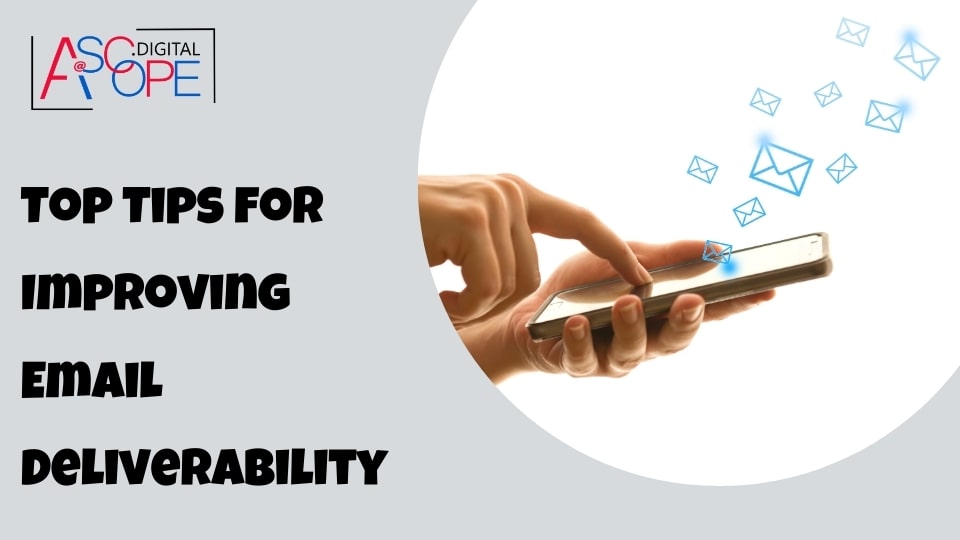Email marketing remains one of the most powerful tools for businesses to engage with their audience, drive conversions, and build lasting relationships. However, achieving high email deliverability can be challenging, with various factors influencing whether your emails land in the inbox or the dreaded spam folder. In this comprehensive guide, we’ll explore top tips for improving email deliverability, ensuring your messages reach their intended recipients and maximize your marketing efforts.
Understanding Email Deliverability

Email deliverability refers to the ability of your emails to successfully reach your subscribers’ inboxes. It’s influenced by multiple factors, including sender reputation, email content, and recipient engagement. Ensuring high deliverability rates is crucial because even the most compelling emails are ineffective if they don’t reach your audience.
Build a Quality Email List
The foundation of high email deliverability is a quality email list. Focus on building a list of engaged, interested recipients rather than buying or renting lists. Use double opt-in methods where subscribers confirm their interest, reducing the chances of invalid or uninterested contacts. Regularly clean your list to remove inactive subscribers, reducing the risk of sending to invalid addresses.
Use a Reputable Email Service Provider
Partnering with a reputable Email Service Provider (ESP) is essential. A good ESP offers features like IP warming, authentication protocols, and deliverability monitoring. They also provide tools to manage your list, segment your audience, and analyze your email performance, helping you maintain high deliverability rates.
Authenticate Your Emails
Email authentication helps verify that your emails are genuinely from your domain, reducing the chances of being marked as spam. Implement protocols like SPF (Sender Policy Framework), DKIM (DomainKeys Identified Mail), and DMARC (Domain-based Message Authentication, Reporting & Conformance). These protocols authenticate your emails and protect your domain from spoofing and phishing attacks.
Maintain a Good Sender Reputation
Your sender reputation significantly impacts your email deliverability. ISPs (Internet Service Providers) use it to determine whether your emails are spam. Maintain a good sender reputation by sending relevant content, avoiding spammy practices, and ensuring your emails are compliant with regulations like CAN-SPAM and GDPR. Monitor your sender reputation using tools provided by your ESP or third-party services.
Segment Your Email List
Segmenting your email list allows you to send targeted, relevant content to different groups within your audience. Segmentation increases engagement rates, which positively impacts your sender reputation and deliverability. Segment based on factors like demographics, purchase history, and engagement levels to tailor your messages effectively.
Optimize Email Content
Content plays a crucial role in email deliverability. Ensure your subject lines are clear and relevant, avoiding spammy words and excessive punctuation. Keep your email body concise and focused, with a clear call to action. Use a mix of text and images, ensuring your emails are mobile-friendly. Avoid excessive use of images or large attachments that may trigger spam filters.
Manage Engagement

Recipient engagement is a key indicator for ISPs to determine the relevance of your emails. Encourage engagement by sending personalized, valuable content and avoiding overly promotional messages. Track metrics like open rates, click-through rates, and conversions to understand what resonates with your audience. Remove inactive subscribers to maintain a high engagement rate and reduce the risk of being marked as spam.
Monitor Bounce Rates
High bounce rates can negatively impact your sender reputation and deliverability. Regularly monitor and manage hard and soft bounces. Hard bounces indicate invalid email addresses and should be removed from your list immediately. Soft bounces are temporary issues, but if an address repeatedly soft bounces, consider removing it to maintain list health.
Avoid Spam Traps
Spam traps are email addresses used by ISPs and anti-spam organizations to identify spammers. Sending to spam traps can severely damage your sender reputation and deliverability. Avoid spam traps by building your list organically, maintaining list hygiene, and monitoring for inactive or invalid addresses.
Comply with Email Regulations
Compliance with email regulations is crucial for maintaining good deliverability. Familiarize yourself with laws like the CAN-SPAM Act (US), GDPR (Europe), and CASL (Canada). Ensure your emails include necessary elements like a clear unsubscribe link, your physical mailing address, and proper sender identification. Respect subscriber preferences and avoid sending unsolicited emails.
Use a Consistent Sending Schedule
Consistency in your sending schedule helps ISPs recognize your sending patterns, positively impacting your deliverability. Determine the best frequency and timing for your audience by testing and analyzing your email performance. Avoid sudden spikes in email volume, which can trigger spam filters.
Test Before Sending
Before sending your emails, test them to ensure they display correctly across different devices and email clients. Use tools to preview your emails and identify potential issues. Perform A/B testing to compare different versions of your emails and determine what works best for your audience.
Monitor Deliverability Metrics
Regularly monitor deliverability metrics to identify and address issues promptly. Key metrics to track include delivery rate, bounce rate, open rate, click-through rate, and spam complaints. Analyzing these metrics helps you understand your email performance and make data-driven decisions to improve deliverability.
Warm Up Your IP Address
If you’re using a new IP address or have a low sending volume, warm it up gradually to build a positive sender reputation. Start by sending small volumes to engaged subscribers and gradually increase the volume over time. Warming up your IP address signals to ISPs that you’re a legitimate sender, improving your deliverability.
Use Engagement-Based Segmentation
Engagement-based segmentation involves dividing your email list based on how subscribers interact with your emails. Segmenting by engagement levels allows you to send more targeted and relevant content, improving your deliverability. For example, send more frequent emails to highly engaged subscribers and re-engagement campaigns to less engaged ones.
Implement a Preference Center
A preference center allows subscribers to manage their email preferences, such as the type of content they want to receive and the frequency of emails. Implementing a preference center can reduce unsubscribe rates, improve engagement, and positively impact your deliverability. Ensure the preference center is easy to access and use.
Leverage Data Analytics
Data analytics can provide valuable insights into your email performance and deliverability. Use analytics tools to track key metrics, identify trends, and understand subscriber behavior. Leverage this data to optimize your email campaigns, improve engagement, and maintain high deliverability rates.
Avoid Blacklists
Being listed on a blacklist can severely impact your email deliverability. Monitor your sender reputation and check regularly if your IP address or domain is listed on any blacklists. If you find yourself on a blacklist, identify the cause and take immediate action to resolve the issue and request delisting.
Personalize Your Emails
Personalization enhances the relevance and engagement of your emails. Use subscriber data to personalize content, such as addressing recipients by name and tailoring messages based on their interests and behavior. Personalized emails are more likely to be opened and acted upon, positively impacting your deliverability.
Foster Subscriber Trust
Building trust with your subscribers is essential for maintaining high deliverability. Be transparent about what subscribers can expect from your emails, and deliver on those promises. Avoid deceptive practices, respect subscriber preferences, and provide valuable content consistently. Trustworthy senders are less likely to be marked as spam, improving deliverability.
Implement Feedback Loops
Feedback loops allow you to receive notifications when subscribers mark your emails as spam. Implementing feedback loops with major ISPs helps you identify and address issues promptly, reducing spam complaints and improving your sender reputation. Use this feedback to refine your email strategy and enhance deliverability.
Use Clear and Consistent Branding
Consistent branding helps subscribers recognize your emails, reducing the likelihood of them being marked as spam. Use a clear and recognizable sender name, and maintain consistent branding elements like logos, colors, and email templates. Clear and consistent branding builds trust and improves deliverability.
Maintain a Strong Email Infrastructure
A robust email infrastructure supports high deliverability. Ensure your email servers are properly configured, use dedicated IP addresses if possible, and monitor server performance regularly. A strong infrastructure reduces the risk of technical issues and improves the overall deliverability of your emails.
Engage with Inactive Subscribers

Re-engaging inactive subscribers can improve your overall engagement rates and deliverability. Develop re-engagement campaigns to win back inactive subscribers, offering incentives or asking for feedback on their preferences. If re-engagement efforts fail, consider removing inactive subscribers from your list to maintain list health.
Avoid Overloading Subscribers
Sending too many emails can overwhelm subscribers and lead to high unsubscribe rates and spam complaints. Find the right balance in your email frequency to keep subscribers engaged without overloading them. Monitor engagement metrics and adjust your sending frequency based on subscriber preferences and behavior.
Use Real-Time Analytics
Real-time analytics provide immediate insights into your email performance, allowing you to address issues promptly. Use real-time analytics tools to track delivery rates, bounce rates, open rates, and other key metrics. Timely insights enable you to make data-driven decisions and optimize your email campaigns for better deliverability.
Implement Advanced Security Measures
Advanced security measures protect your emails and improve deliverability. Use encryption to secure sensitive information, and implement two-factor authentication to protect your email accounts. Advanced security measures enhance your sender reputation and reduce the risk of your emails being marked as spam.
Stay Updated with Industry Best Practices
Email marketing is constantly evolving, with new best practices and technologies emerging regularly. Stay updated with industry trends, attend webinars, and participate in forums to learn from experts and peers. Adopting the latest best practices helps you maintain high deliverability and stay ahead of the competition.
Partner with Deliverability Experts
If you’re facing persistent deliverability issues, consider partnering with deliverability experts. These professionals can provide in-depth analysis, identify root causes, and recommend tailored solutions to improve your email deliverability. Partnering with experts ensures you receive the best advice and support for optimizing your email campaigns.
Foster a Culture of Compliance
Compliance with email regulations is crucial for maintaining high deliverability. Foster a culture of compliance within your organization, educating your team about relevant laws and best practices. Regularly review your email practices and ensure they align with regulatory requirements, protecting your sender reputation and deliverability.
Monitoring and Optimizing Your Email Campaigns
Once you’ve implemented best practices for email deliverability, it’s crucial to continuously monitor and optimize your campaigns. Utilize analytics tools to track key metrics such as open rates, click-through rates, and bounce rates. These insights will help you identify which strategies are working and which need adjustment. Regularly clean your email list to remove inactive or incorrect email addresses, as a clean list improves your sender reputation and deliverability rates. Additionally, A/B testing different elements of your emails, such as subject lines and call-to-actions, can reveal what resonates best with your audience. A well-optimized email campaign not only reaches more of your subscribers but also engages them effectively, leading to higher conversion rates. Thus, improving traffic and sales for your website. Read more on the other reasons why your website isn’t getting traffic. By staying proactive and responsive to your email performance data, you can continually refine your approach to maximize deliverability and overall email marketing success.
Conclusion
Improving email deliverability requires a comprehensive approach, focusing on list quality, sender reputation, engagement, and compliance. By implementing these top tips, you can enhance your email deliverability, ensuring your messages reach your audience and drive successful marketing outcomes. Remember, continuous monitoring, testing, and optimization are key to maintaining high deliverability rates and maximizing the impact of your email campaigns.


